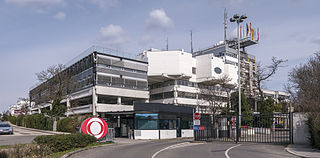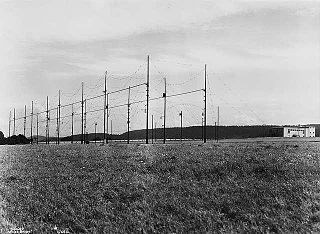The early history of radio is the history of technology that produces and uses radio instruments that use radio waves. Within the timeline of radio, many people contributed theory and inventions in what became radio. Radio development began as "wireless telegraphy". Later radio history increasingly involves matters of broadcasting.

NRK is the Norwegian government-owned radio and television public broadcasting company, and the largest media organisation in Norway. All other TV channels, broadcast from Norway, were banned between 1960 and 1981. NRK broadcasts three national TV channels and three national radio channels on digital terrestrial television, digital terrestrial radio and subscription television. All NRK radio stations are streamed online at NRK.no, which also offers an extensive TV service. NRK is a founding member of the European Broadcasting Union.

The British Broadcasting Company Ltd (BBC) was a British commercial company formed on 18 October 1922 by British and American electrical companies doing business in the United Kingdom. Licensed by the British General Post Office, their original office was located on the second floor of Magnet House, the GEC buildings in London and consisted of a room and a small antechamber. On 14 December 1922, John Reith was hired to become the Managing Director of the company at that address. The company later moved its offices to the premises of the Marconi Company. The BBC as a commercial broadcasting company did not sell air time but it did carry a number of sponsored programmes paid for by British newspapers. On 31 December 1926, the company was dissolved, and its assets were transferred to the non-commercial and crown-chartered British Broadcasting Corporation (BBC).

Österreichischer Rundfunk is an Austrian national public service broadcaster. Funded from a combination of television licence fee revenue and limited on-air advertising, ORF is the dominant player in the Austrian broadcast media. Austria was the last country in continental Europe after Albania to allow nationwide private television broadcasting, although commercial TV channels from neighbouring Germany have been present in Austria on pay-TV and via terrestrial overspill since the 1980s.
Telefunken was a German radio and television apparatus company, founded in Berlin in 1903, as a joint venture of Siemens & Halske and the Allgemeine Elektricitäts-Gesellschaft (AEG).

Johan Ludwig Mowinckel (22 October 1870 – 30 September 1943) was a Norwegian statesman, shipping magnate and philanthropist. He served as the Prime Minister of Norway during three separate terms.
Stiftelsen Norsk Luftambulanse is a Norwegian humanitarian organisation, organised as a non-profit foundation. It primarily promotes and operates helicopter air ambulance services. As of 2014, they operate seven Eurocopter EC135 and one EC145 helicopters out of seven bases in Norway, based on contracts with the state through the Norwegian Air Ambulance. In Denmark, they operate three EC135 out of three bases.
As of March 1st 2016, Telenor Maritim Radio changed it's name to Telenor Kystradio. Telenor Kystradio is a part of Telenor and provides maritime telecommunication services along the coast of Norway, operating networks of marine VHF radio, medium frequency, high frequency and Navtex transmitters. As of January 2018 there are two costal radio stations in Norway, Kystradio nord and Kystradio sør. The agency also issues marine radio licenses for both commercial- and pleasure ships, including callsigns and Maritime Mobile Service Identities, as well as radio operator certificates. Telenor Kystradio head office is based at Telenor Norway's head office at Fornebu. Telenor Kystradio also performs GMDSS Radio inspections, and are approved by the Norwegian Maritime Authority as well as most mayor classification authorities. The Radioinspeksjonen is located in Oslo, Stavanger, Bergen, Ålesund, Sandnessjøen, Bodø, Lofoten and Troms.

Georg Wilhelm Alexander Hans Graf von Arco was a German physicist, radio pioneer, and one of the joint founders of the "Society for Wireless Telegraphy" which became the Telefunken company. He was an engineer and the technical director of Telefunken. He was crucial in the development of wireless technology in Europe.

Norkring AS is a provider of digital terrestrial television and radio transmitting in Norway and Belgium. In Norway, Norkring operates a Digital Video Broadcasting – Terrestrial (DVB-T) network for Norges Televisjon, as well as a FM and Digital Audio Broadcasting (DAB) radio. In Belgium, Norkring operates a DVB-T, DVB-T2, FM, DAB and DAB+ network. It operated a DVB-T network in Slovenia between 2010 and 2012. Norkring is owned by Telenor; Norkring België is owned 75 percent by Norkring and 25 percent by Participatiemaatschappij Vlaanderen.
Events in the year 1963 in Norway.
Jens Bache-Wiig was a Norwegian engineer and industrialist.

Norsk Spisevognselskap A/S, often abbreviated NSS or shortened to Spisevognselskapet, was a Norwegian state enterprise which operated restaurant carriages on Norwegian trains and restaurants at railway stations and railway hotels. The company was established in December 1918, and started a catering service in 1919. Originally owned by the Norwegian Trunk Railway, it was acquired by the state in 1926. Meals served in the restaurant carriages were relatively expensive, although they were available to all passengers. In the 1950s, the company began using serving trolleys on trains.

Isfjord Radio is a coast radio station, weather station and hotel located at Kapp Linné on the island Spitsbergen in Svalbard, Norway. The station was established in 1933, and has played an important role in the telecommunications between the Svalbard archipelago and the outside world. The station was destroyed by both sides during World War II, and rebuilt in 1946. The station was important for ships traffic and air traffic. Satellite communications were established in 1979, but deprecated when a fiber optic cable between Svalbard and the mainland was finished in 2004. Isfjord Radio was automated and depopulated in 1999. Parts of the outdated installations have been preserved as a historical site.
Gunnar Nygaard was a Norwegian broadcasting pioneer. He was born in Kristiania. He was educated in telegraphy, and a pioneer in the technical development of broadcasting in Norway. He took part in the first experimental broadcasting from Tryvasshøgda, starting in 1923. From 1933 he worked for the Norwegian Broadcasting Corporation. During the German occupation of Norway Nygaard established and operated a Norwegian short-wave transmitter in the United States, in particular targeting Norwegian sailors. Back in Norway he established a short-wave radio for seamen, which opened in Fredrikstad in 1948. He was awarded the St. Olav Medal in 1964.
The history of broadcasting in Australia has been shaped for over a century by the problem of communication across long distances, coupled with a strong base in a wealthy society with a deep taste for aural communications in a silent landscape. Australia developed its own system, through its own engineers, manufacturers, retailers, newspapers, entertainment services, and news agencies. The government set up the first radio system, and business interests marginalized the hobbyists and amateurs. The Labor Party was especially interested in radio because it allowed them to bypass the newspapers, which were mostly controlled by the opposition. Both parties agreed on the need for a national system, and in 1932 set up the Australian Broadcasting Commission, as a government agency that was largely separate from political interference.

Jeløy Radio is a radio station situated on the peninsula of Jeløya in Moss, Norway. It currently only operates as an unmanned coast radio station operating marine VHF radio connected to Tjøme Radio and a Navtex service operated from Vardø Vessel Traffic Service Centre.

The Compagnie générale de la télégraphie sans fil was a French company founded in 1918 during a reorganization and expansion of the Société française radio-électrique (SFR), which became a subsidiary. The company developed technology for radio-telegraphy, radio program transmission, radar, television and other applications. It provided broadcasting and telegraphy services, and sold its equipment throughout the French colonial empire and in many other parts of the world. In 1968 CSF merged with the Thomson-Brandt to form Thomson-CSF.

Hans Bredow was a German radio broadcasting pioneer and the first chairman of Weimar Germany's National broadcasting service. He is regarded as the "father of German broadcasting".












